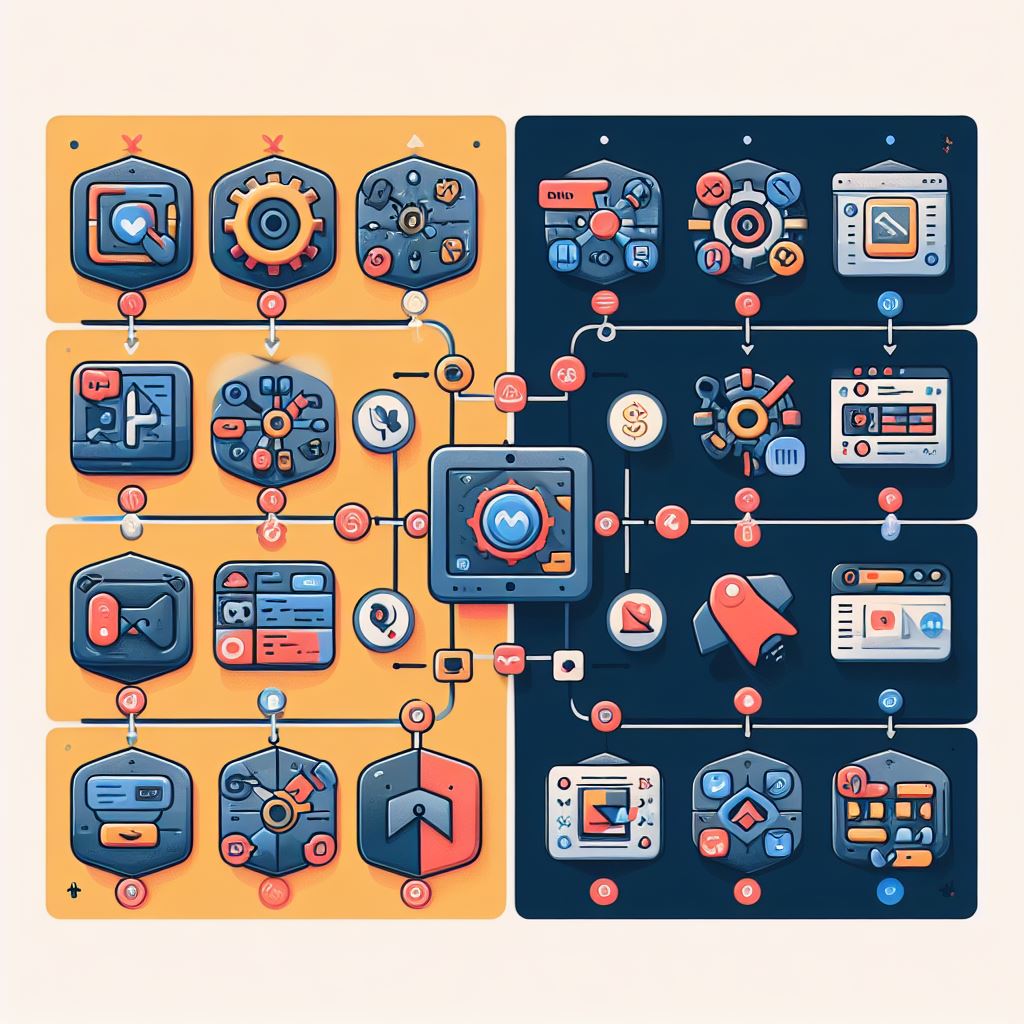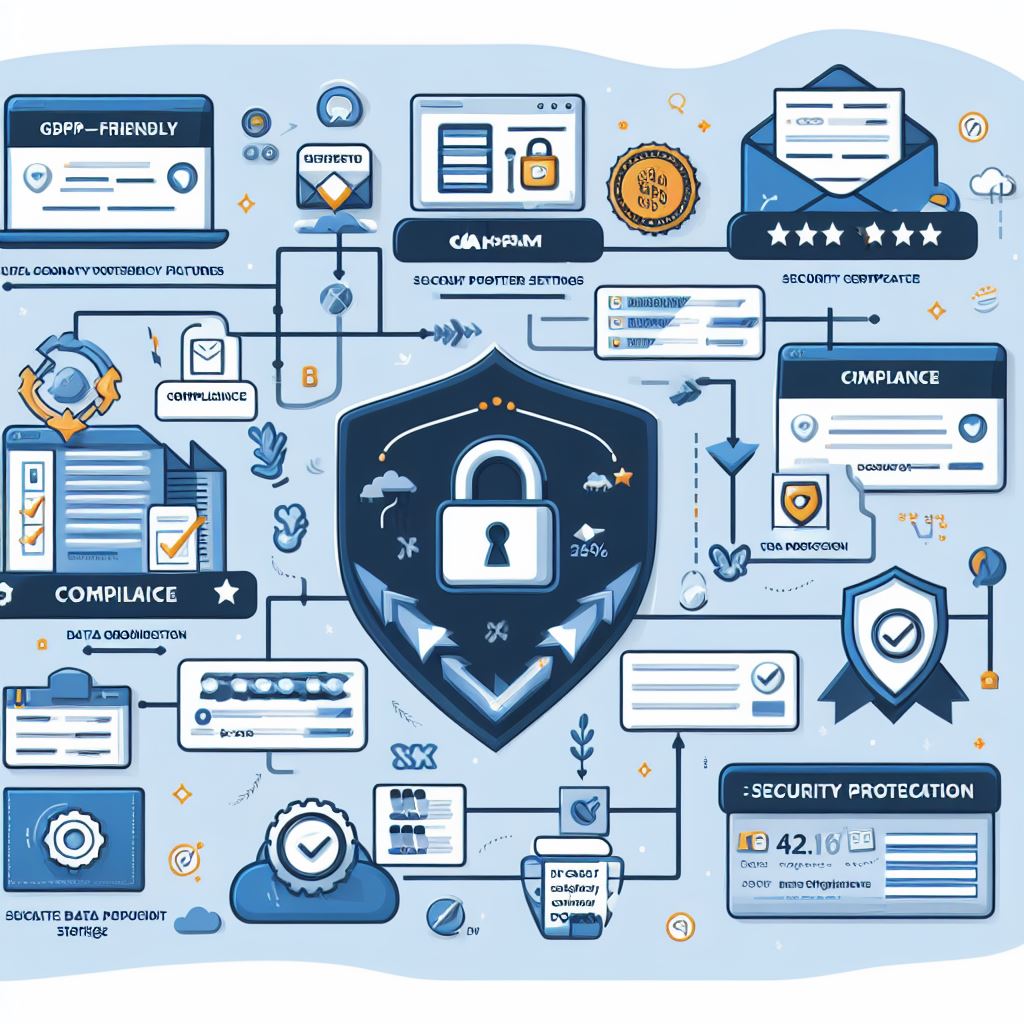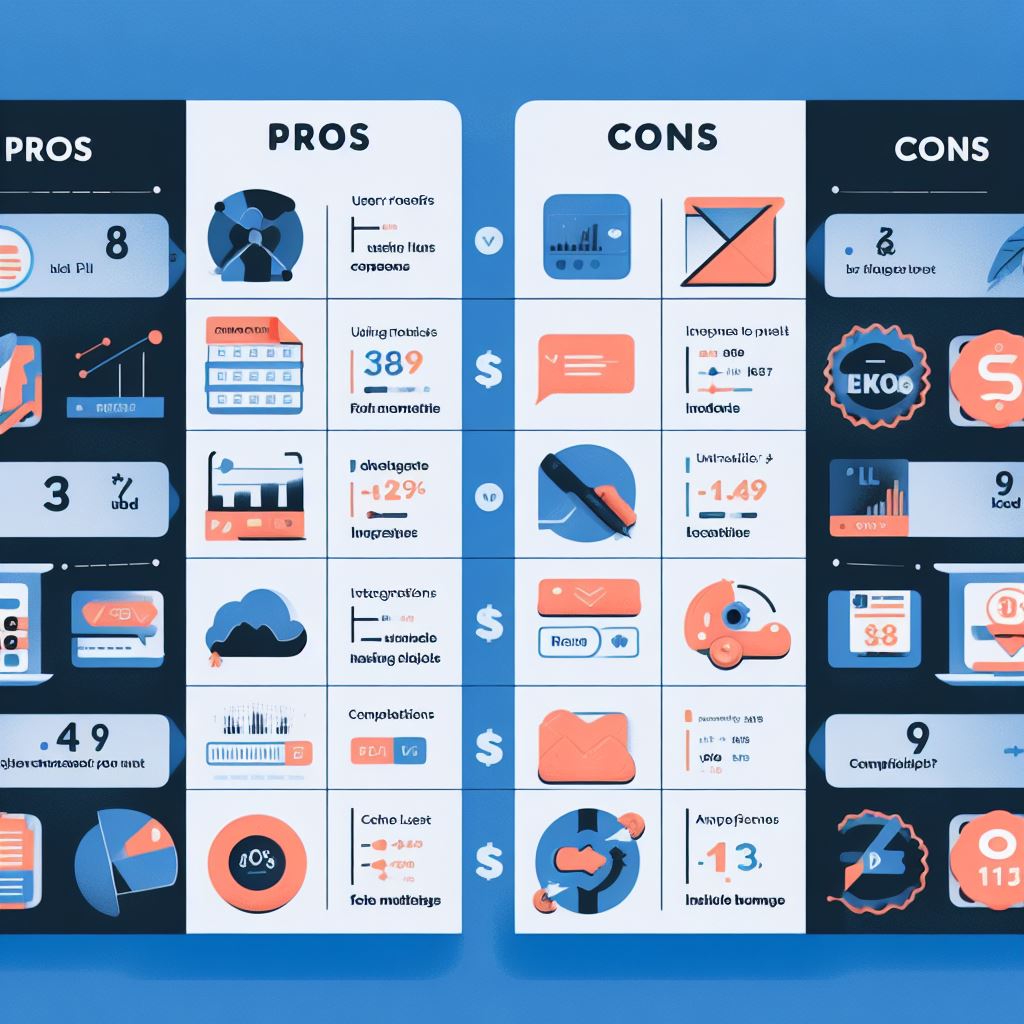MailerLite vs MailChimp: which email marketing service should you choose for your business’s digital marketing success? The decision can have a significant impact on the effectiveness of your campaigns. These two platforms are often compared for their unique features and offerings. This blog post aims to provide a detailed comparison to help you decide which tool, MailerLite or MailChimp, aligns best with your business objectives. From ease of use to cost-efficiency and advanced functionalities, we’ll explore the pros and cons to aid in your selection.
Table of Contents
Ease of Use of Mailerlite vs Mailchimp
When comparing MailerLite vs MailChimp, the aspect of ‘ease of use’ stands out as a pivotal factor for many users. Both platforms aim to streamline the email marketing process, but they take slightly different approaches.
Starting with MailerLite, the interface is widely recognized for its simplicity and clarity. The minimalist design is not just aesthetically pleasing but also functional, making it a suitable choice for beginners. Navigation is straightforward, with a dashboard that puts all the essential features within a click’s reach. Setting up a campaign with MailerLite is a breeze, thanks to its intuitive drag-and-drop editor. Users can quickly create emails without needing a background in design or coding.
On the other hand, MailChimp offers a robust set of features that are well-organized within its interface. However, the abundance of options can be overwhelming for new users. That said, once you get past the learning curve, MailChimp’s user interface provides powerful tools at your disposal. The service offers a comprehensive step-by-step guide for first-time users, which greatly aids in understanding how to use the platform to its full potential.
Where ease of use really comes into play is in the day-to-day operations. Both MailerLite and MailChimp offer visual campaign builders, but MailerLite’s streamlined approach tends to reduce the time it takes to get a campaign up and running. Conversely, MailChimp’s design functionalities are more advanced, which might require more time investment upfront but can pay off with more sophisticated campaign structures.
It’s important to consider the support provided by each service. MailerLite has a reputation for accessible and responsive customer support, which enhances its user-friendliness. MailChimp, while offering extensive support, can sometimes be slower to respond, according to some user reviews.

Email Design and Templates
In the debate of MailerLite vs MailChimp, the area of email design and templates is crucial for marketers seeking to engage their audience with visually appealing emails. Both platforms offer a variety of options, but there are distinct differences worth noting.
MailerLite’s design philosophy is centered around ease and intuitiveness. It provides users with a clean, straightforward template editor. The available templates are elegantly simple, which makes it quick and easy to create beautiful emails. Users can customize templates to fit their brand, with no advanced skills necessary. The focus is on delivering a user-friendly experience that does not sacrifice the quality of the final product.
MailChimp, renowned for its robust design options, offers a wider array of templates compared to MailerLite. With its advanced template editor, users can dive into the nitty-gritty of email design, enjoying a greater level of customization. The templates range from basic layouts to more intricate designs, catering to a broader spectrum of design needs. MailChimp’s templates are also responsive, ensuring emails look great on all devices—a feature MailerLite matches.
For users weighing MailerLite vs MailChimp, it’s important to consider the nature of their email marketing campaigns. If simplicity and speed are priorities, MailerLite’s templates may be more appealing. For those who relish creative control and have the time to delve into detailed customizations, MailChimp’s extensive template library might be more beneficial.

Email Automation Features
Email automation is at the heart of efficient and effective email marketing, allowing for timely, relevant, and personalized communication with audiences.
MailerLite offers a straightforward automation system, making it accessible even for those new to email marketing. Its automation tools allow users to create workflows that trigger based on subscriber actions, such as joining a list or opening a previous email. MailerLite’s simplicity, however, does not mean it lacks capability. It offers advanced options such as time delays, conditions, and even the ability to move subscribers to different groups based on their behavior, allowing for a personalized approach to email campaigns.
MailChimp, in contrast, provides a more comprehensive set of automation features, suitable for both beginners and advanced users. It has a wide variety of pre-built workflows for different purposes, such as welcome sequences, re-engagement campaigns, and more. MailChimp’s automation capabilities are highly customizable, with detailed segmentation and behavioral targeting options that can be tailored to very specific marketing strategies.
The choice between MailerLite and MailChimp’s email automation features may come down to the level of complexity required for your email marketing strategy. MailerLite keeps it simple and user-friendly, while MailChimp offers depth and breadth, potentially accommodating more complex marketing funnels.

List Management and Segmentation
The comparison of MailerLite vs MailChimp regarding list management and segmentation is a critical discussion point for marketers aiming to target their emails effectively. Proper management of subscriber lists and the ability to segment those lists into targeted groups are essential for personalized marketing campaigns, which can significantly impact engagement rates and ROI.
MailerLite’s approach to list management is user-friendly and straightforward, providing a clean and intuitive interface for organizing subscribers. You can create groups and segments based on subscriber data, which is especially useful for sending targeted content. What’s notable about MailerLite is its simplicity in executing these tasks, without compromising on the functionality that most small to medium-sized businesses require.
MailChimp, on the other hand, offers a highly sophisticated system for list management and segmentation. It allows for the creation of complex segments based on a multitude of criteria, including subscriber behavior and e-commerce activity. This makes MailChimp a powerful tool for marketers who need to create highly targeted emails. Additionally, MailChimp’s predictive insights feature can help in creating segments based on predicted demographics and behavior, a valuable asset for advanced marketing strategies.
For readers interested in “MailerLite vs MailChimp,” the decision often hinges on the level of detail required in their segmentation and the size of their subscriber base. MailerLite offers a more than adequate solution for most, while MailChimp stands out for those who need advanced segmentation capabilities.

Deliverability
When comparing MailerLite vs MailChimp, deliverability is arguably one of the most critical factors to consider. Deliverability refers to the ability of your emails to successfully land in your subscribers’ inboxes, rather than being caught by spam filters or rejected by email servers.
MailerLite prides itself on high deliverability rates. This is achieved through their stringent adherence to email sending best practices and a proactive approach to maintaining their sender reputation. Users benefit from features like automatic list cleaning, which helps in reducing bounce rates by removing invalid email addresses from your lists.
MailChimp also boasts a strong deliverability record, backed by a sophisticated infrastructure and an aggressive stance against spam. Advanced features like time-warp sending and send-time optimization help in reaching subscribers when they are most likely to open their emails, which can positively impact overall deliverability rates.
When it comes to “MailerLite vs MailChimp,” both services offer comprehensive resources and tools to help users understand and improve their email deliverability. The choice may come down to which additional deliverability features align best with your specific email marketing strategies.

Integration and Compatibility
The debate over “MailerLite vs MailChimp” extends into how each platform integrates with other software systems, a vital consideration for businesses looking to create a seamless tech stack. Integration and compatibility are paramount in ensuring that email marketing efforts work in tandem with other business tools such as CRM systems, e-commerce platforms, and productivity applications.
MailerLite offers a robust set of integrations with popular software applications. These integrations are designed to be straightforward, allowing users to connect their email marketing activities with other services without needing extensive technical knowledge. Notably, MailerLite integrates with major e-commerce platforms, website builders, and CRM systems, which can help users in automating workflows and data synchronization.
MailChimp, known for its extensive marketplace of integrations, boasts compatibility with a wide array of services and apps. This range from industry-standard CRM systems to specialized e-commerce solutions. Moreover, MailChimp’s API allows for custom integrations, providing the flexibility needed for more complex or unique business requirements.
Choosing between MailerLite and MailChimp for integration and compatibility will often come down to the specific tools you use within your business and the complexity of the integrations you need. MailerLite is often lauded for its ease of use, while MailChimp offers greater depth and flexibility.

Reporting and Analytics
In the “MailerLite vs MailChimp” comparison, the capabilities for reporting and analytics stand out as a crucial aspect for marketers who need to track the success of their campaigns and understand subscriber behavior. Effective reporting tools can help refine strategies and enhance the impact of email marketing efforts.
MailerLite’s reporting features are user-friendly and provide essential data like open rates, click rates, and subscriber growth over time. This information can be invaluable for marketers looking to quickly gauge the performance of their campaigns. Moreover, MailerLite allows users to view campaign reports on the go with a mobile app, ensuring you have access to your data wherever you are.
MailChimp takes analytics a step further with more detailed reports that not only include the basics but also advanced metrics like subscriber lifetime value and comparative reporting. For e-commerce businesses, MailChimp offers specialized reports that track purchases and revenue, making it a powerful tool for measuring ROI from email campaigns.
When deciding between MailerLite and MailChimp based on reporting and analytics, it’s essential to consider the level of detail and the specific metrics you require to effectively monitor your email marketing.

Customer Support
When it comes to selecting an email marketing service, the level of customer support provided can be just as important as the features. In the debate of MailerLite vs MailChimp, both offer distinct support experiences that cater to different user needs.
MailerLite is known for its straightforward and responsive customer support. With 24/7 email support and a comprehensive knowledge base, users can expect prompt assistance at any time. Furthermore, MailerLite offers live chat support, which is particularly beneficial for urgent queries that need immediate attention. For those new to email marketing, this level of support can be incredibly reassuring.
MailChimp, on the other hand, provides an extensive range of support options. Their paid plans include 24/7 email and live chat support, with the addition of phone support for more immediate and complex issues. MailChimp also boasts a vast resource library with guides, tutorials, and marketing tips to help users self-serve many of their needs. The availability of advanced support options like these is a testament to MailChimp’s commitment to customer service.
Choosing between MailerLite and MailChimp for customer support may come down to personal preference—whether you prefer the assurance of live support at any hour or the depth of self-service resources.

Pricing and Plans
Deciding between MailerLite and MailChimp often comes down to the details of their pricing and plans. The cost-effectiveness of an email marketing service is a crucial factor, particularly for small businesses and startups that need to manage their budgets carefully.
MailerLite is celebrated for its affordability and the value it provides. It offers a free plan for up to 1,000 subscribers, which includes access to most of its features, making it an attractive option for those just starting out or with a small list. As the needs grow, MailerLite’s pricing scales with the number of subscribers, maintaining competitive rates and ensuring that you only pay for what you use.
MailChimp, recognized for its comprehensive service, has a slightly different pricing strategy. It also offers a free plan, but with a cap on the number of emails you can send per month. Its paid plans are tiered based on features and the size of the subscriber list, and can become costlier, especially if you need access to advanced features like segmentation and multivariate testing.
Both services offer transparency in their pricing structures, with no hidden fees, which is critical for users to plan their finances. The choice between MailerLite and MailChimp in terms of cost will depend on your specific needs, the size of your subscriber list, and the features that are most important to you.

Compliance and Security
In the realm of email marketing, compliance and security are not just buzzwords—they are essential pillars that sustain the integrity of digital communication strategies. With regulations like GDPR, CAN-SPAM, and CCPA dictating the do’s and don’ts of email outreach, it’s crucial to partner with an email service that diligently upholds these standards.
Compliance ensures that your email campaigns adhere to legal standards, protecting both the sender and the recipient. Services like MailerLite and MailChimp offer features that help manage consent and provide easy-to-use options for subscribers to opt out, which are key elements of maintaining compliance.
Security, on the other hand, safeguards your data and the privacy of your subscribers. Both MailerLite and MailChimp employ robust security measures including data encryption, secure data centers, and regular audits to prevent unauthorized access and data breaches.

User Reviews and Community Feedback
User reviews and community feedback are invaluable assets for any email marketing service like MailerLite or MailChimp. They provide potential and existing customers with honest insights into the product’s performance and the quality of service offered. Here’s a closer look at how user reviews and feedback can inform your choice and usage of an email marketing platform.
User Reviews: These are first-hand accounts from individuals who have used MailerLite or MailChimp for their email marketing needs. Reviews often cover a range of topics, including ease of use, feature set, customer support, and overall satisfaction. When reading through user reviews, look for common patterns that can indicate the strengths or weaknesses of the service.
Community Feedback: This typically comes from forums, social media, and direct customer testimonials. Community feedback can often be more dynamic and may include tips, hacks, and use-case discussions that can provide deeper insights into how well a service performs in real-world scenarios.

Pros and Cons Summary
When considering an email marketing platform like MailerLite or MailChimp, it’s important to weigh the advantages and disadvantages to determine if it aligns with your business goals and operations. Here is a brief summary of the pros and cons associated with these services.
Pros:
- User-Friendly Interface: Both platforms are praised for their intuitive designs, which make it easy for beginners to navigate and create campaigns.
- Feature-Rich: Offering a wide array of features, from automation to segmentation, these services cater to various email marketing strategies.
- Integrations: Extensive integration options with other services and applications enhance functionality and streamline workflows.
- Support and Resources: Comprehensive support channels, including knowledge bases, tutorials, and customer support teams, are readily available.
Cons:
- Pricing Variations: As your mailing list grows, the cost can increase significantly, which might not be ideal for smaller businesses or those with a tight budget.
- Complexity of Advanced Features: Some users may find the advanced features a bit complex, requiring a learning curve to fully utilize them.
- Limited Design Options: There might be limitations in design flexibility, which can be a downside for brands with a strong visual identity.

Conclusion and Recommendations
To sum up, the exploration of various facets of email marketing tools brings us to a pivotal point where making a choice becomes paramount for the success of your digital marketing strategy. MailerLite emerges as a highly competent option, offering a harmonious blend of user-friendly design and advanced features that cater to both novice and experienced email marketers.

Here are some key takeaways and recommendations:
- Simplicity Meets Power: MailerLite’s platform exemplifies how a straightforward design does not compromise on the depth of features. For those who prioritize an uncluttered user experience alongside powerful marketing tools, MailerLite is a fitting choice.
- Cost-Effectiveness: With competitive pricing structures, MailerLite presents an attractive proposition for budget-conscious businesses without skimping on essential features.
- Customer Engagement: Through its suite of personalization and automation tools, MailerLite facilitates a higher level of engagement with your audience, translating to better conversion rates and customer retention.
- Support System: Stellar customer support stands as a pillar of MailerLite’s service, ensuring that help is readily available when you need to navigate through any challenges or queries.
Recommendations for Optimal Use:
- Leverage Automation: Utilize MailerLite’s advanced automation features to save time and personalize communication with your subscribers.
- Segment Your Audience: Take advantage of segmentation to deliver targeted and relevant content, which can significantly increase your open and click-through rates.
- Analyze and Adapt: Regularly review the comprehensive analytics provided by MailerLite to understand subscriber behavior and refine your campaigns for better results.





